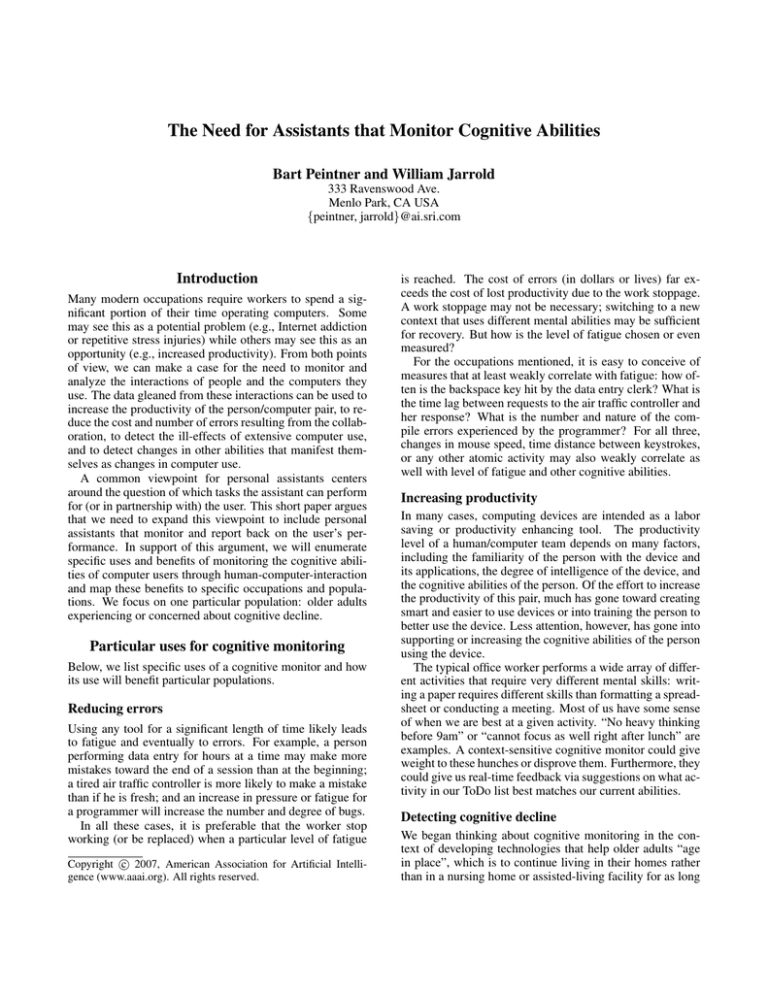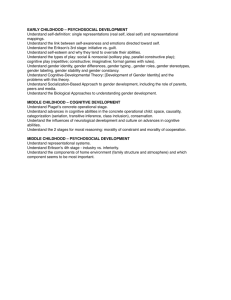
The Need for Assistants that Monitor Cognitive Abilities
Bart Peintner and William Jarrold
333 Ravenswood Ave.
Menlo Park, CA USA
{peintner, jarrold}@ai.sri.com
Introduction
Many modern occupations require workers to spend a significant portion of their time operating computers. Some
may see this as a potential problem (e.g., Internet addiction
or repetitive stress injuries) while others may see this as an
opportunity (e.g., increased productivity). From both points
of view, we can make a case for the need to monitor and
analyze the interactions of people and the computers they
use. The data gleaned from these interactions can be used to
increase the productivity of the person/computer pair, to reduce the cost and number of errors resulting from the collaboration, to detect the ill-effects of extensive computer use,
and to detect changes in other abilities that manifest themselves as changes in computer use.
A common viewpoint for personal assistants centers
around the question of which tasks the assistant can perform
for (or in partnership with) the user. This short paper argues
that we need to expand this viewpoint to include personal
assistants that monitor and report back on the user’s performance. In support of this argument, we will enumerate
specific uses and benefits of monitoring the cognitive abilities of computer users through human-computer-interaction
and map these benefits to specific occupations and populations. We focus on one particular population: older adults
experiencing or concerned about cognitive decline.
Particular uses for cognitive monitoring
Below, we list specific uses of a cognitive monitor and how
its use will benefit particular populations.
Reducing errors
Using any tool for a significant length of time likely leads
to fatigue and eventually to errors. For example, a person
performing data entry for hours at a time may make more
mistakes toward the end of a session than at the beginning;
a tired air traffic controller is more likely to make a mistake
than if he is fresh; and an increase in pressure or fatigue for
a programmer will increase the number and degree of bugs.
In all these cases, it is preferable that the worker stop
working (or be replaced) when a particular level of fatigue
c 2007, American Association for Artificial IntelliCopyright gence (www.aaai.org). All rights reserved.
is reached. The cost of errors (in dollars or lives) far exceeds the cost of lost productivity due to the work stoppage.
A work stoppage may not be necessary; switching to a new
context that uses different mental abilities may be sufficient
for recovery. But how is the level of fatigue chosen or even
measured?
For the occupations mentioned, it is easy to conceive of
measures that at least weakly correlate with fatigue: how often is the backspace key hit by the data entry clerk? What is
the time lag between requests to the air traffic controller and
her response? What is the number and nature of the compile errors experienced by the programmer? For all three,
changes in mouse speed, time distance between keystrokes,
or any other atomic activity may also weakly correlate as
well with level of fatigue and other cognitive abilities.
Increasing productivity
In many cases, computing devices are intended as a labor
saving or productivity enhancing tool. The productivity
level of a human/computer team depends on many factors,
including the familiarity of the person with the device and
its applications, the degree of intelligence of the device, and
the cognitive abilities of the person. Of the effort to increase
the productivity of this pair, much has gone toward creating
smart and easier to use devices or into training the person to
better use the device. Less attention, however, has gone into
supporting or increasing the cognitive abilities of the person
using the device.
The typical office worker performs a wide array of different activities that require very different mental skills: writing a paper requires different skills than formatting a spreadsheet or conducting a meeting. Most of us have some sense
of when we are best at a given activity. “No heavy thinking
before 9am” or “cannot focus as well right after lunch” are
examples. A context-sensitive cognitive monitor could give
weight to these hunches or disprove them. Furthermore, they
could give us real-time feedback via suggestions on what activity in our ToDo list best matches our current abilities.
Detecting cognitive decline
We began thinking about cognitive monitoring in the context of developing technologies that help older adults “age
in place”, which is to continue living in their homes rather
than in a nursing home or assisted-living facility for as long
as possible. We are studying ways to provide older adults
and their caregivers feedback on the current cognitive abilities of the older adult. We believe that a (trusted) cognitive
monitor will provide several benefits:
Reduced stress for the caregiver The worry that a loved
one is declining physically or mentally is a cause of constant stress for a caregiver. A mechanism for constant
feedback (beyond repeated phone calls) will help ease this
stress.
Guided choice of interventions Knowing which cognitive
abilities are declining or improving will help a system or
caregiver choose an appropriate intervention. There is a
growing focus on cognitive games (a.k.a. serious games),
which are in some cases proven to increase particular cognitive abilities of their players.
Evaluation of interventions Older adults often suffer from
multiple ailments and diseases, which require multiple
drugs that interact in ways doctors cannot always predict.
Monitoring the cognitive (and physical) performance of
the person before and after medication changes will help
quantify the total effect of the drug cocktail, and possibly
detect sudden drops that could lead to physical injury.
Proposed Approach
Our specific approach to building a cognitive monitor for
older adults involves instrumenting their personal computers and telephones (in a privacy-preserving way) to collect
data; 32% of adults over 65 use the Internet, up from 22% in
2004 (Pew 2006), making computer use ripe for monitoring.
A key aspect of our cognitive monitor is that it is unobtrusive, and requires little if any change in the user’s computer
habits. For the older adults population, we intend to perform
three types of measurements.
Motor skills
Several neuropsychological tests, such as the Finger Tapping
Test, measure neuro-motor abilities. This cognitive ability
likely correlates with many human-computer interactions,
including mouse speed, time between keystrokes, and the
‘double-click’ interval. Preliminary work suggests that time
between keystrokes can be used to indicate mild cognitive
impairment (Jimison, Pavel, & McKanna 2005). Other measures cut across several cognitive abilities. For example, the
relative frequency of “backspace” may predict neuro-motor
abilities (how often the intended key was missed) or language abilities (misspellings or cannot think of a word.)
Linguistic and speech analysis: written and oral
We are interested in language content as a clinical indicator of mental and even physical health. A body of prior
research indicates that aspects of cognitive and emotional
functioning can be predicted on the basis of a computerbased analysis of the words used in communication. Pennebaker et al. (Pennebaker, Mehl, & Niederhoffer 2003)
and Bechtel et al. (Bechtel et al. 2002) describe how computer based lexical analysis can be applied to the problem
of detecting cognitive impairment. Email is an obvious data
source for this analysis. However, oral communication is
an attractive source as well. By applying automatic speech
recognition (ASR) technology to a consenting patient’s telephone conversations, one will have an even larger and more
ecologically-valid sample of the patient’s linguistic patterns.
In addition to language content, oral fluency is an important diagnostic indicator. Cognitive impairment can be indicated by a general slowness in speech or by halting speech
(Haley & Vanderploeg 2000). We believe ASR can be applied to the problem of detecting changes in oral fluency.
Performance on applications
If instrumented, certain applications can give valuable information about a user’s executive functions, memory, and intelligence. Performance on a trivia game, crossword puzzle,
or even a race car game has obvious connections to many
cognitive abilities. The challenge in this case is to separate
the user’s natural improvement (learning) in the game from
changes in the core cognitive abilities. One study has shown
that performance on the game FreeCell can be used to predict mild cognitive impairment (Jimison et al. 2004).
Conclusion
In the near future, we intend to implement a longitudinal
study in which we assess a set of older adults using both traditional, clinical neuropsychological tests and our computer
measures. The data from the study should enable an analysis that leads to a predictive model linking the measures and
levels of particular cognitive abilities.
We believe that in the quest for truly helpful personal assistants, we should not focus solely on what actions or decisions we can delegate to the assistants; we should also consider the potential role of AI in monitoring our own actions
and decisions to help us maintain and improve our own performance. The potential benefits of developing this area of
research include reduced errors, increased productivity, and
detection of temporary of long-term cognitive decline.
References
Bechtel, R. J.; Franklin, D. L.; Gottschalk, L. A.; Harrington,
D. E.; Katz, M. L.; Levinson, D. M.; Maguire, G. A.; and Nakamura, K. 2002. Computer detection of cognitive impairment and
associated neuropsychiatric dimensions from the content analysis
of verbal samples. American Jrnl of Drug and Alcohol Abuse 28.
Haley, J. A., and Vanderploeg, R. D. 2000. Clinician’s Guide to
Neuropsychological Assessment. Lawrence Erlbaum Associates.
Jimison, H. B.; Pavel, M.; Pavel, J.; and McKanna, J. 2004.
Home monitoring of computer interactions for the early detection
of dementia. In Intl. Conf. of the Engineering in Medicine and
Biology Society, 4533–4536.
Jimison, H. B.; Pavel, M.; and McKanna, J. 2005. Unobtrusive
computer monitoring of sensory-motor function. In Intl. Conf. of
the Engineering in Medicine and Biology Society, 5431–5434.
Pennebaker, J.; Mehl, M.; and Niederhoffer, K. 2003. Psychological aspects of natural language use: Our words, our selves.
Annual Review of Psychology 54:547–577.
Pew Internet and American Life Project. 2006. Internet penetration and impact. http://www.pewinternet.org.




